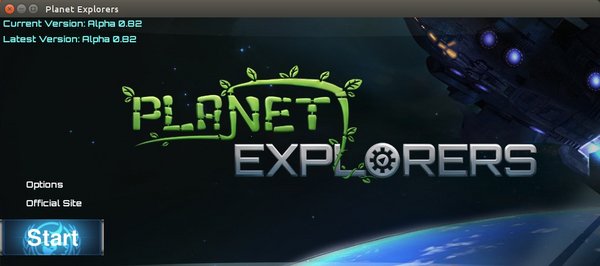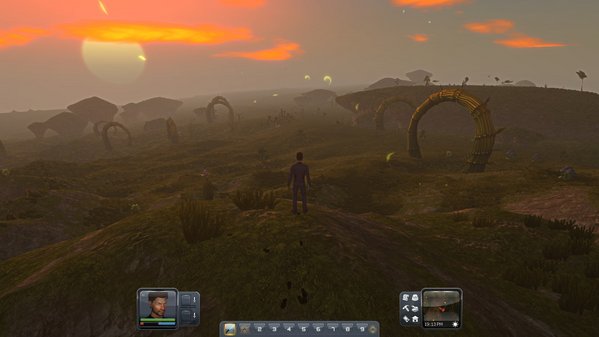Welcome to thatlinuxbox.com Thursday, December 18 2025 @ 04:20 PM UTC
Planet Explorers Game on Linux
- Wednesday, July 23 2014 @ 10:47 PM UTC
- Contributed by: Dan Stoner
- Views: 27,843

This week, save 40% off Planet Explorers on Steam. http://store.steampowered.com/app/237870/

The graphics are beautiful:

I had no stutter or performance issues at all on my Ubuntu 14.04 system. From Additional Drivers, I am using the NVIDIA binary driver - version 331.38 from package nvidia-331.
For reference, my hardware includes...
Intel(R) Core(TM) i5-2400 CPU @ 3.10GHz
NVIDIA Corporation GK106 [GeForce GTX 650 Ti Boost]
Gameplay seems to have some features of Minecraft... within a few minutes I was able to dig for stone and metals, harvest plant life, hunt animals for meat, and get attacked by some kind of predator. The online videos I have seen show people building defenses and other structures.
Here are additional screenshots from my Linux system:
- read more (92 words)
- Comments (0)
Upgrade Home Desktop Computer, Still Running Linux
- Monday, July 01 2013 @ 11:02 PM UTC
- Contributed by: Dan Stoner
- Views: 14,716

I last blogged about my desktop computer in 2010. Some of that has not changed (mouse, keyboard, computer case, ...), but I finished upgrading motherboard, CPU, memory, hard drive, and graphics card and WOW this machine is BLAZING FAST! The SATA3 SSD helps my system boot to the login screen in under 10 seconds! I'm pleased that I got so much use out of those old components but now I will hand them down to another Linux user.
The nVidia GTX650 Ti BOOST graphics card that I bought from NewEgg was new enough that the standard drivers available for Ubuntu 12.04 LTS did not support it. After some struggle, the driver package nvidia-319 from "Edgers" PPA did the trick and I have amazing graphics for gaming. Here are some screenshots of Linux gaming, all running natively...
Portal:

Dungeon Defenders:

Serious Sam 3 BFE:

These screenshots of the nVidia control panel (nvidia-settings) show some details of the graphics card and drivers:
- read more (830 words)
- Comments (0)
Steam and Team Fortress 2 on Linux
- Saturday, February 23 2013 @ 12:57 PM UTC
- Contributed by: Dan Stoner
- Views: 9,226


I stopped gaming a few years back when my dual-booted install of Windows crapped out. I decided I wasn't going to re-install Microsoft Windows again. I started spending time doing a lot of things other than playing video games.
My desktop computer is somewhat old. I'm still using the same hardware I posted in 2010. The graphics card is an ATI 4850 (DIAMOND 4850PE3512 Radeon HD 4850 512MB 256-bit GDDR3 PCI Express 2.0 to be exact) which I bought in 2008 for $195 and is the most I have ever paid for a graphics card. The motherboard and CPU are hand-me-downs, so most of the components in the system are at least 5 years old. One of the things that I love about GNU/Linux is that my computer is still quite happy running the latest editions of the open source operating system.
However, getting Steam and TF2 running on this older hardware was not completely trivial. As of a few days ago, the Steam client provided by the Steam web site is 32-bit and does not install correctly on my 64-bit Ubuntu workstation (complaining about Wrong architecture 'i386'). Once I made it past that obstacle, I installed TF2 from my Steam Library, but it would quickly error out because the Ubuntu-provided ATI proprietary drivers were missing a required OpenGL feature:
'Required OpenGL extension "GL_EXT_texture_sRGB_decode" is not supported. Please update your OpenGL driver.'

Many of the suggestions on the net did not work on my system (for example, using the Ubuntu-provided experimental driver packages). However, I'm encouraged that the folks at Canonical, Steam, and AMD are continuing to work on the issue and improve the situation. I would expect that the Ubuntu Software Center may have updated package and drivers over the next few weeks / months (if it does not already) so the solution below may not be required.
But in the meantime, I found a way to get Steam and TF2 working on ATI Legacy adapters (in particular the 4xxx and 5xxx series). Most of this information is available via searching google and reading various forums. Thank you, Internet!
Here are the 3 steps that finally worked for me:
- read more (259 words)
- Post a comment
- Comments (0)
Specify QUERY_STRING to PHP CLI
- Sunday, December 02 2012 @ 03:25 PM UTC
- Contributed by: Dan Stoner
- Views: 14,277

specify query parameters *without* having to modify any of the PHP code to parse the arguments / options. Most of the examples on the net suggest modifying the PHP script to parse the argv options. I also did not have luck using environment variables to specify QUERY_STRING.
For example, take a Joomla! article with a URL something like this:
mysite/index.php?option=com_content&id=10
Many people running Joomla have SEO-friendly URLs enabled, but the above is the simple (simplest?) query string to get to a particular article using the article id.
Now we can test a particular article at this site from the command line.
Change directory to the appropriate document root and run php as a command-line program:
$ php index.php '&option=com_content&id=10'
The magic sauce is that the first character of the query argument list is just another ampersand rather than the traditional question mark.
Why would I want to do this at all? As one of the Linux system administrators responsible for helping our University customers with their hosted web sites, I sometimes have to debug unusual issues. Having system administrators modify production customer code is not standard practice and unfortunately some of our web hosting customers are not saavy enough to debug unusual issues themselves. One of the tools in our sysadmin toolbox is strace. If I can get the script to repeat the behavior in the command line while strace is running I can often determine the cause of the issue. Running the script in the cli is frequently much easier than trying to catch the issue with strace on a live production site, in shared web infrastructure, etc. We can see file accesses failing, network requests to external servers that don't allow the php page to render until after the remote content is fetched, slow performance from a mysql database... all via the output of strace.
- Comments (0)
Cluster SSH
- Wednesday, January 25 2012 @ 12:05 AM UTC
- Contributed by: Dan Stoner
- Views: 11,220

ClusterSSH is a nice tool for manipulating multiple *nix machines simultaneously. For example, if I want to run some commands on two Linux machines named server1 and server2, I could:
# cssh server1 server2
And I will get two xterm windows that I can control simultaneously by typing into the cssh command window. Since cssh will send keystrokes to both servers, any series of commands can be run, including editing files, etc. I have found that my daily patterns of behavior make cssh preferable to similar tools such as pdsh. Also, cssh uses very similar options syntax to the ssh command, so I don't have to remember different options (I frequently use -l and -p).
I might want to tail the logs on all of the machines in the cluster, but then focus in on one particular machine after I have identified a particular cluster node of interest. Similarly, I might work out a long command line on a single node before running it on the rest of the machines via the cssh command window.
In Debian and Ubuntu, cssh can be installed with:
# sudo apt-get install clusterssh
Cluster SSH is also available for Mac OS X (http://code.google.com/p/csshx/).
A clusterssh package seems to be working its way into Red Hat flavors via Extras or 3rd party repos such as rpmforge.
After running cssh for the first time, you will have a .csshrc file in your home directory. This file can be tweaked in various ways to make connecting to groups of machines easier. To save a group of machines into a list that you can re-use, cssh can use a plain text cluster file.
To use a cluster file:
- read more (172 words)
- Comments (0)








 Twitter
Twitter
 LinkedIn
LinkedIn
 GitHub
GitHub


